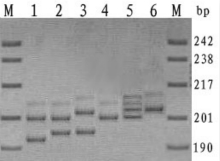IAS Identified the Genetic Diversity of FecB Gene and Microsatellite GC101 Which is Associated with Reproduction Selection in Sheep
Source: Author:By Liu Qiuyue Date:2015-08-14
The mutton sheep and goat genetics and breeding team led by Professor Mingxing Chu in Institute of Animal Sciences of CAAS, reported that the FecB gene of Chinese sheep affecting fecundity might derive from Chinese local area. The result of this study was published in Turkish Journal of Veterinary and Animal Sciences on Aug 3, 2015.FecB(Fec=fecundity, B=Booroola) mutation was firstly identified in Booroola Merino sheep based on segregation studies on litter size and ovulation rate. It is a major gene responsible for high prolificacy in sheep and has been widely used for sheep breeding improvement for many years. Microsatellite GC101 being a marker is closely linked with FecB gene. The aims of this study were to reveal the changes of genetic diversity of both FecB gene and microsatellite GC101 in reproduction selection of sheep.
Our study found that there was the same FecB mutation (A746G) in both Small Tail Han and Hu sheep as that in Booroola Merino ewes, but not in Texel and Dorset sheep. Seven alleles from 192 bp to 210 bp and 20 genotypes were detected at GC101 locus in 447 individuals totally. The preponderant allele was 200 bp for Chinese sheep and 202 bp for western sheep. Linkage analysis showed that there was strong linkage disequilibrium between 200 bp allele of GC101 locus and B allele of FecB gene (r2=0.639). These results preliminarily implied that both 200 bp allele of GC101 locus and B allele of FecB had been reinforced in reproduction selection of Chinese sheep. The differentiation of GC101 allele distribution between Chinese sheep and western sheep also indicated that the FecB of Chinese sheep might derive from Chinese local area.

By Liu Qiuyue
qiuyue1983921@163.com